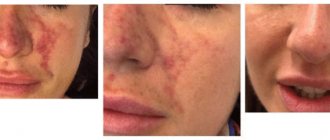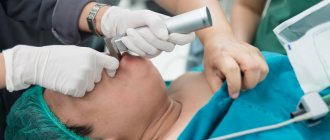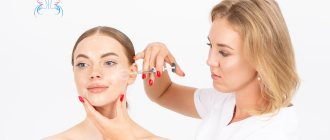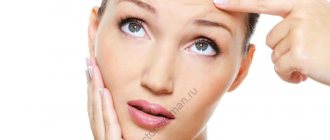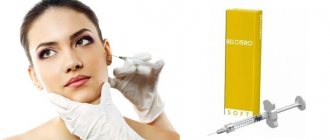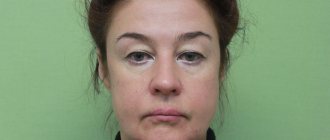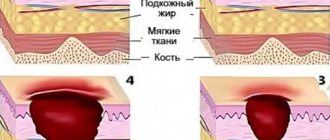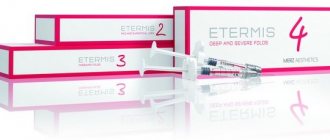The full original article “Clinical and morphological aspects of side effects during facial contouring with biodegradable fillers” can be read in the journal “Annals of Plastic, Reconstructive and Aesthetic Surgery, No. 4 2015”
The increasing use of fillers is understandable because the drugs have few side effects, the procedures are easily tolerated, and the results are predictable and relatively durable. All this, as well as an aggressive pricing and advertising policy, stimulates their widespread use even by inexperienced specialists, often without professional medical education.
As the number of procedures increased, the number of complications also increased. These can be either minor complications that do not require intervention, or quite serious complications that need to be treated in a specialized clinic.
Recently, the number of patients who came to our clinic with complications after the introduction of injection implants has increased. Often patients did not even know what drugs were used during implantation.
It should be noted that side effects/complications were eliminated only after surgical removal of the fillers and the products of their interaction with body tissues.
Results and discussion
Side effects and complications in the early stages after filler injection
In the early stages after injections, patients complained of pain, swelling, redness, bumpiness and unevenness of the skin; as a rule, no serious medical procedures were required.
When fillers were introduced to correct glabellar wrinkles and nasolabial folds, swelling and hematomas were most often observed. Such patients sought help almost immediately after injections (up to 1 month). No special treatment was carried out in such cases; these patients were monitored dynamically. In two cases, an inflammatory process was observed in the area where the injection implant was inserted. The patients were prescribed an oral broad-spectrum semisynthetic penicillin antibiotic, Amoxicillin 500 mg (tablets).
Complications in the late stages after contour plastic surgery
In some patients, in the long term after the filler injection procedure, deformation of the contours of the facial skin was observed; in some cases, we noted its migration, the formation of scar deformation and calcifications in the soft tissues. After injections into the lip area, patients complained of asymmetry and deformation of the lips; we observed the formation of lip granulomas. Complications associated with the introduction of filler in combination with lipofilling were noted.
Side effects/complications were eliminated only after the fillers and the products of their interaction with body tissues were removed surgically.
Swelling after lip augmentation with hyaluronic acid
Swelling after lip augmentation: why it develops and what to do
Lips are rightfully considered one of the main symbols of female sexuality.
They attract the gaze of men, making the face of a young beauty or a woman in her prime truly expressive, emotional and beautiful. Lip augmentation using dermal fillers is one of the most popular areas of injection cosmetology. The technique is used not only to add volume, but also to model the contour, easily change the shape or projection, and eliminate age-related imperfections. Minor swelling after lip augmentation is a normal response to the injection of hyaluronic acid. Synthetic “hyaluronic acid”, like natural HA produced by the body, is highly hydrophilic. This means that it attracts and holds water molecules. Therefore, moderate swelling in the first days is a normal, even desirable reaction.
But what to do if swelling after the procedure turns into an aesthetic problem. And why is this happening? Medical cosmetologists (Moscow) will help you understand the intricacies of the possible causes of hypertrophied responses.
How is the procedure performed?
You need to start from the beginning, that is, from the process of injecting hyaluronic acid under the skin. It is preceded by thorough treatment of the skin with antiseptic agents. The goal is obvious - to kill microflora, which can cause the development of an infectious process. If skin cleansing is not done thoroughly enough, the cause of swelling after hyaluronic acid injections may not be the filler with its hydrophilic activity, but simple inflammation due to the addition of an infection.
Injections begin from the central zone, that is, first the cosmetologist injects the filler into the center of the lips. Then he chips around the periphery. After the injections, a light massage is performed to promote uniform distribution of the volume-forming gel over the entire correction area. If any technical errors are made during the manipulation, the result of improper distribution of hyaluronic acid may be the appearance of swelling.
At the final stage, the cosmetologist once again treats the skin at the injection sites with an antiseptic, after which he applies a special mask with a soothing and anti-inflammatory effect. The use of cooling preparations with anti-exudative (anti-edematous) and anti-inflammatory effects after injections of hyaluronic acid is one of the conditions for successful recovery after the procedure.
So, severe swelling after lip augmentation with hyaluronic acid may be a consequence of:
- Development of an infectious-inflammatory process in the injection area. (As a rule, inflammation is accompanied by redness of the skin).
- Violations of manipulation techniques.
- Incorrect completion of the session (without a soothing mask, or using ineffective means).
A few words need to be said about the importance of a correct assessment of the initial state of the skin and mucous membranes. An experienced cosmetologist must analyze the patient’s skin type, the severity of subcutaneous tissue, age and the degree of age-related changes. Concomitant diseases, for example, latent herpes infection (the procedure is not performed if labial herpes is active), should also be taken into account.
Based on an analysis of the patient’s individual characteristics, the cosmetologist selects a dermal filler with a certain degree of viscosity. For lip augmentation, mainly medium or low density preparations are used, but within these categories the gradation is quite large. To avoid the negative consequences of contouring, trust beauty, health and youth only to experienced and qualified specialists.
Recovery period rules
The benefits of contouring are well known to every woman. The procedure gives instant and predictable results. The effect is visible immediately after lip augmentation with hyaluronic acid. There is no need to wait several days or even months, as happens after plastic surgery.
Another advantage is the simplicity of the recovery period. It is enough to follow a few simple rules for 3-5 days, after which you can forget about all restrictions. Add to this an excellent safety profile - hyaluronic acid is biologically compatible with the tissues of the human body - and we get an almost ideal beauty technology!
Everything said above is absolutely true, but this does not mean that there is no recovery period after the procedure at all. Yes, it is short and painless, but some rules must be followed strictly and strictly. The following are the main recommendations:
- Lip care after lip augmentation with fillers should be gentle. Decorative cosmetics, various balms, glosses and even hygienic lipstick cannot be used. At least in the first 2-3 days.
- Touch your mouth with your hands as little as possible, otherwise the risk of infection increases. The skin has been damaged and its barrier and protective functions are temporarily weakened. There is no need for an unnecessary collision with pathogenic microflora now.
- In the first days after the procedure, you should not kiss. The rule is simple, but the temptation to break it can be too great. It's better not to do this.
- It is advisable to avoid overly expressive facial expressions. Laugh less, smile less.
- You need to take a break from sports for a couple of days. An increase in body temperature during physical activity leads to increased peripheral circulation, which, in turn, contributes to the development of swelling.
- For the same reason, you should avoid visiting the solarium. In addition, ultraviolet radiation can cause minor damage to the skin tissue and provoke responses that increase swelling.
A few words about nutrition after lip surgery. Of course, contouring cannot be compared with rhinoplasty, but some nutritional principles are similar. In the first days, it is advisable to drink water (and other drinks) through a straw. Hot and cold foods should be completely avoided. Food should be at body temperature or, if appropriate, room temperature. It is better to avoid solid foods; if possible, eat liquid or pureed foods.
You should not get carried away with vegetables and fruits, as the acids they contain can cause irritation of the skin and mucous membranes. Another parallel with rhinoplasty concerns oral care. You need to brush your teeth after lip augmentation carefully, trying not to injure vulnerable tissues. It is better not to use various dental rinses for a couple of days.
How to quickly remove swelling
In most cases, moderate or even severe swelling is explained by the body's individual reaction to skin damage during injections. Infectious and inflammatory complications are extremely rare, provided that the procedure is performed in a clinic by an experienced cosmetologist using a certified drug.
How to help the body recover faster after hyaluronic acid injections? First, you must follow the rules listed above. Secondly, you can apply cooling compresses to the skin. Cold reduces peripheral blood flow and prevents swelling. Just don’t need to keep the cold heating pad constantly, a short exposure of 5-7 minutes is enough.
In case of severe swelling, you can use pharmaceutical products for topical use that have anti-exudative and anti-inflammatory effects. You should not choose them yourself. Be sure to consult with the cosmetologist who performed the injections. Use only those medications that he recommends.
What you definitely shouldn’t do is be guided by the principle “desperate times call for desperate measures.” To reduce swelling, there is no need to apply salt compresses to the skin, take diuretics, “drive away water” in the sauna, run to the solarium or get a massage. All this is contraindicated after lip augmentation! Such actions will only lead to increased swelling.
If you do nothing, the swelling will go away on its own in three, maximum, four or five days (if this does not happen, consult a specialist). After this time, only delicious lips will remind you of the procedure, which will make your face more expressive and sexy!
Delayed swelling after contouring. What to do and who is to blame?
Edema is the accumulation of fluid in extracellular tissues of the body. Swelling is a standard reaction of tissues to their damage and accompanies any medical intervention, including contouring. In the normal course of events, swelling goes away within 2-3 days. If we are talking about lip contouring, swelling can last longer - up to 10 days. If swelling does not subside or occurs some time after the intervention, it is likely that we are talking about delayed edema.
Doctor of Medical Sciences, plastic surgeon Elena Ivanovna Karpova, talks about the causes of delayed edema after contour plastic surgery .
One such factor is persistent infection. This term refers to a dormant infection that is activated when the body’s protective properties decrease or when provoking factors occur. The example given by Elena Ivanovna of a patient who was injected with an absorbable drug along with a non-absorbable one injected a decade and a half ago is quite typical. Combining such drugs is a precipitating factor for persistent infection and increases the risk of delayed edema. In this case, aseptic inflammation occurred.
The quality of the injected filler directly affects the appearance of persistent edema. The hyaluronic acid preparation must be from a reputable manufacturer and of a high degree of purification. We wrote about fillers here.
But delayed swelling can also occur when the correct and highly purified drug is injected. It can be triggered by a focus of inflammation in the patient’s body. For example, dental granuloma or chronic sinusitis. When immunity decreases, the infection is activated, causing inflammation in the form of swelling surrounding the drug.
How can complications such as edema be prevented during contouring?
Firstly, you need to contact a highly qualified specialist. We have already written that he must be certified by the manufacturer and have a specialization as a cosmetologist and dermatovenerologist. The technique of drug administration plays an important role in preventing subsequent delayed edema. An experienced and competent doctor avoids a large number of punctures, and injects the drug through one or two punctures, changing the direction of the needle as the space is filled.
Secondly, the clinic must have a positive reputation and be equipped with the most modern equipment in accordance with all legal requirements.
The next important factor is to consult a doctor immediately at the first signs of any disturbance in the body - a sudden increase in temperature, increasing swelling, the appearance of bruises or irregularities on the skin. Any unusual symptom should alert you and be a reason to contact a specialist. The following rule works here: if the injections were performed by a competent and trustworthy specialist working at a reputable institution, then you can return to him again, he will correct all the consequences without any difficulties. However, if the procedure was carried out at home, outside an institution and by a self-taught specialist, it is better to correct his mistakes with more qualified doctors.
What do doctors recommend doing against edema?
You can apply ice, but not for long, so as not to overcool the tissue and get a cold burn. The doctor may prescribe a course of antihistamines if he finds signs of an allergic reaction. In some cases, the patient is recommended to consult an immunologist in order to improve immunity. It is also important before contouring to monitor your health status and the presence of “dormant” diseases, such as recurrent herpes or diseases of the oral cavity. In general, any chronic infectious diseases are at risk for filler injections.
The patient's behavior after the injection largely determines the body's reaction to the procedure. It is recommended to avoid drinking alcohol and foods that promote fluid retention - fatty, fried, salty - for one to two weeks. Avoid saunas and baths, as well as exposure to hot water and sun. You should also not overstrain the body with physical activity and traumatic sports.
Among the contraindications to contour plastic surgery, it is necessary to remember about blood diseases, pregnancy, any diseases of the skin, lactation period, previous injections of other silicone-based drugs, and reduced immunity.
Despite the fact that the injection seems to be a relatively harmless intervention, you must pay extreme attention to the doctor’s recommendations in order to avoid unpleasant complications and unpredictable health consequences.

